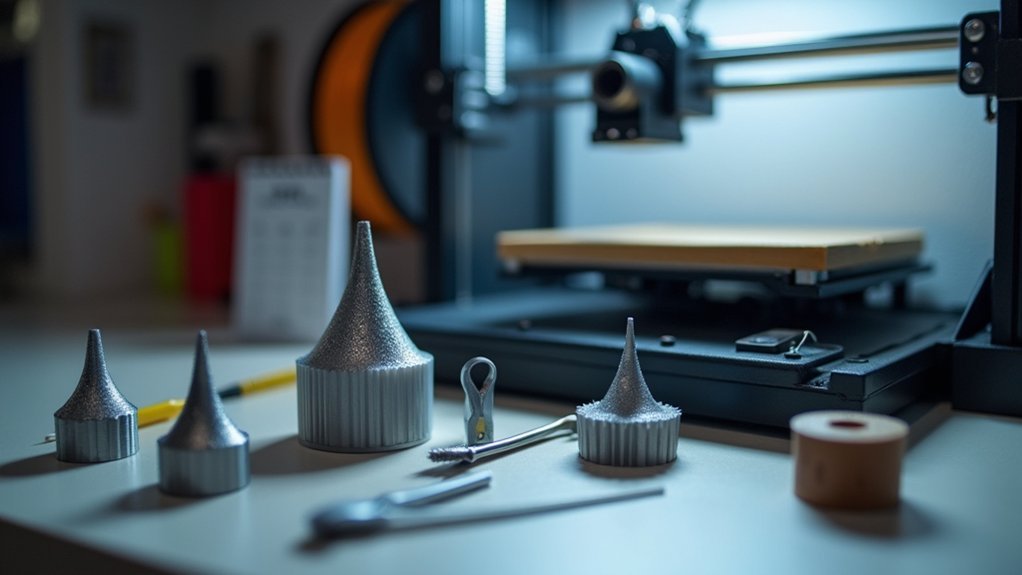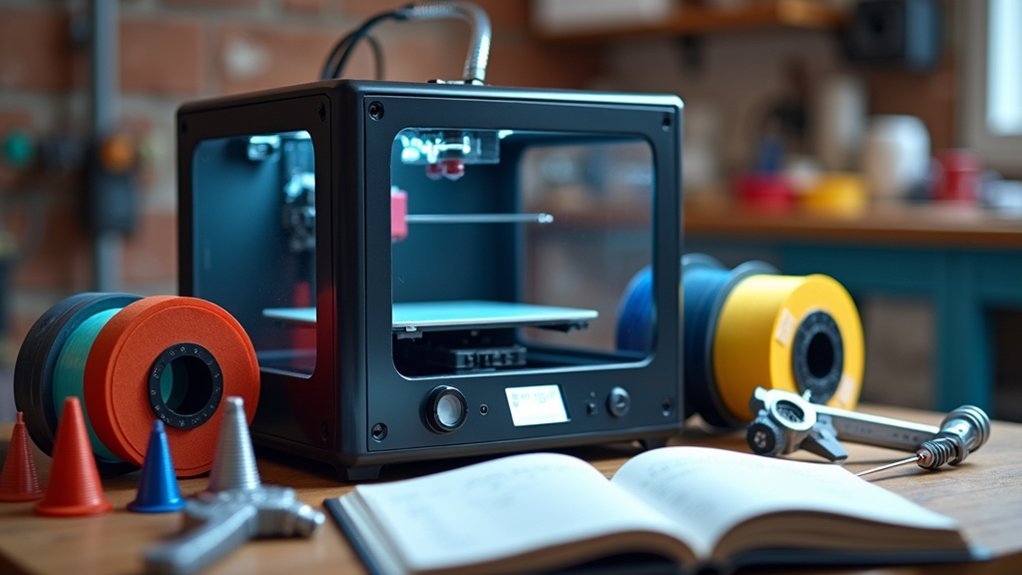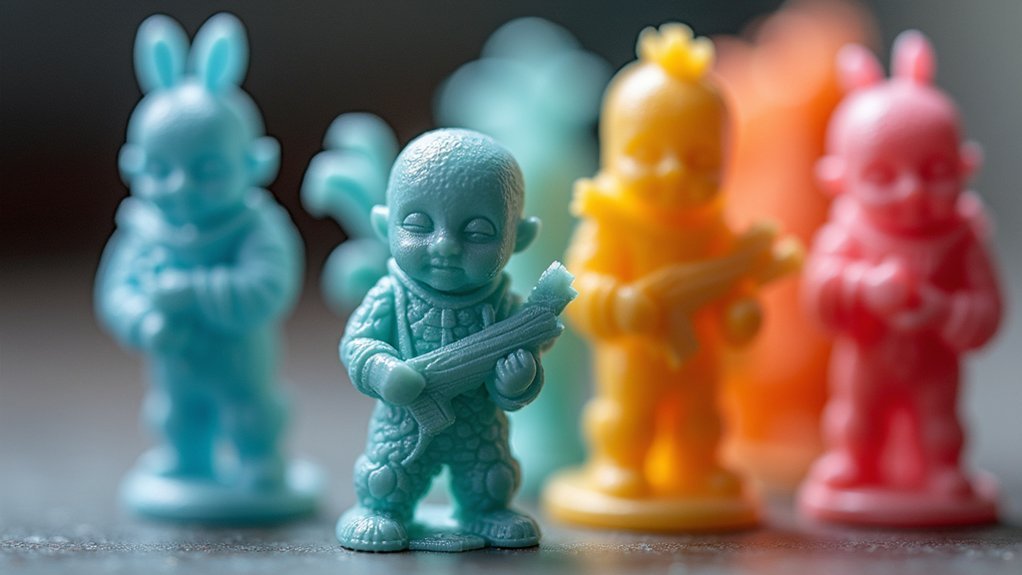Your annual 3D printer maintenance expenses will typically range from $50 to $2,000 depending on your printer type. You’ll spend the most on materials like filament ($20-$50 per kilogram) or resin ($30-$100 per liter), which often exceed your initial printer investment within the first year. Additional costs include replacement parts ($50-$500 annually), professional services ($100-$300), software licensing ($500-$5,000), and energy consumption. Understanding these expense categories will help you budget effectively and discover proven strategies to minimize your long-term operating costs.
Understanding the Components of Annual 3D Printer Maintenance Costs

Several key components determine your annual 3D printer maintenance expenses, and understanding these costs upfront helps you budget effectively for your printing operations.
Your annual maintenance expenses typically range from $50 to $500, depending on your printer type and how frequently you use it.
Replacement parts represent a significant portion of your maintenance budget. You’ll need nozzles, print beds, and fans that cost $10 to $50 each.
Regular cleaning supplies and tools add to your expenses, though these costs remain relatively modest.
Software updates can range from free to several hundred dollars annually.
Professional maintenance services for major repairs can increase your annual expenses by $100 to $300 or more, depending on complexity.
Material Costs: Filament, Resin, and Specialty Consumables
Material costs form the largest ongoing expense in your 3D printing budget, often exceeding your initial printer investment within the first year of regular use. Understanding these expenses helps you plan effectively and optimize your printing budget.
Your material expenses vary greatly by printer type and application:
- FDM filament ranges from $20-$50 per kilogram for standard PLA, while specialty composites can cost $100-$200 per kilogram.
- SLA/DLP resin typically costs $30-$100 per liter, with specialized resins exceeding $400 per liter for advanced applications.
- Maintenance consumables like nozzles and print beds add $50-$200 annually to your material costs.
You’ll reduce expenses through bulk purchasing, which provides substantial discounts on filament and resin.
Smart material selection based on your project requirements prevents unnecessary spending on premium materials.
Replacement Parts and Component Wear Expenses

You’ll encounter several components that wear down with regular use and require periodic replacement throughout your printer’s lifespan.
Print beds and nozzles represent the most frequent replacements, typically costing $20-$50 and $10-$30 respectively, while cooling fans range from $5-$20 each.
Other commonly worn parts include belts and extruders, which contribute to your total annual replacement budget that can range from $50 to $500 depending on usage intensity.
Common Worn Components
While 3D printers are generally reliable machines, certain components inevitably wear down through regular use and require periodic replacement to maintain peak performance.
Understanding these common worn components helps you budget for printer maintenance costs effectively.
The most frequently replaced parts include:
- Print beds – These surfaces endure constant heating and cooling cycles, with replacement costs ranging from $20 to $50 depending on size and material.
- Nozzles – Essential for filament extrusion, these wear out from prolonged use, with replacement packs costing $10 to $30.
- Cooling fans – Critical for proper airflow, these components typically cost $5 to $20 each when replacement becomes necessary.
Belts also require attention as they stretch over time, affecting print precision.
Investing in quality replacement parts guarantees consistent print quality and prevents costly failures.
Replacement Cost Ranges
Since component replacement represents a significant portion of annual 3D printer maintenance expenses, understanding the specific cost ranges for each part helps you create an accurate maintenance budget.
Print beds typically cost $20-$50 depending on size and material composition. You’ll spend $10-$30 for nozzle packs containing multiple replacement nozzles essential for maintaining print quality.
Replacement fans range from $5-$20 each, varying by type and specifications your printer requires. Additional components like belts and other wear items add $10-$50 to your annual maintenance costs.
While original manufacturer parts cost more than generic alternatives, they’re recommended for compatibility and warranty protection. These replacement parts collectively form the bulk of your yearly maintenance investment.
Professional Service and Repair Costs
When your 3D printer encounters complex issues beyond basic troubleshooting, professional service costs become a significant factor in your annual maintenance budget.
You’ll face varying expenses depending on the complexity of problems that arise.
Professional services typically involve these cost considerations:
- Routine maintenance visits range from $100 to $300, covering standard calibration and preventive care
- Complex repairs can exceed $500 when major hardware failures or software issues occur
- Service contracts with manufacturers help manage unpredictable repair costs while ensuring timely assistance
While professional services add to your maintenance expenses, they’re often essential for peak performance.
Professional maintenance services represent a crucial investment that ensures optimal 3D printer performance and prevents costly breakdowns.
Investing in proper setup, calibration, and consistent professional care reduces long-term operating costs by preventing major failures and minimizing costly downtime.
Energy Consumption and Operational Overhead

You’ll find that your 3D printer’s energy consumption extends far beyond the printing process itself, encompassing electricity usage patterns that vary dramatically based on print duration and complexity.
Your facility’s climate control systems must maintain ideal temperature and humidity levels, adding significant overhead costs to your monthly expenses.
Don’t overlook the equipment idle costs when your printer sits powered on between jobs, as these seemingly minor expenses can accumulate into substantial annual operational overhead.
Electricity Usage Patterns
Understanding your 3D printer’s electricity consumption patterns becomes essential for accurate annual budgeting since energy costs can greatly impact your overall operational expenses.
Your printer’s power draw varies markedly between 50 to 500 watts per hour, directly affecting your electricity bills based on how frequently you print.
When calculating your yearly energy consumption, consider these key factors:
- Print duration frequency – Regular 10-hour jobs cost between $0.065 to $0.65 each in electricity
- Printer wattage rating – Higher-powered models consume more energy per operating hour
- Local electricity rates – Your regional rates determine hourly costs from $0.0065 to $0.065
Large-scale printing operations face substantially higher energy expenses.
You’ll need to track cumulative usage patterns when planning annual maintenance expenses, as these costs compound over time with consistent printer operation.
Facility Climate Control
Beyond your printer’s direct power consumption, facility climate control systems add another €0.10 to €0.50 per operating hour to your energy expenses.
You’ll need proper temperature and humidity control to preserve moisture-sensitive filaments and resins, which drives up operational costs considerably. Large-scale printing operations can see hundreds of euros monthly in additional HVAC expenses alone.
However, effective facility climate control isn’t just an expense—it’s an investment in quality and equipment longevity. Proper environmental conditions prevent material degradation, reduce print failures, and extend your printer’s lifespan.
While energy costs for climate systems represent substantial operational overhead, they ultimately lower your long-term maintenance costs by protecting both materials and equipment from environmental damage that would otherwise require expensive repairs or replacements.
Equipment Idle Costs
While your 3D printer sits powered but unused, it’s still burning through €0.10 to €0.50 per hour in energy consumption costs—money that adds up quickly when multiplied across days or weeks of inactivity.
Equipment idle costs extend beyond electricity bills. Your operational overhead continues accumulating regardless of production status:
- Facility expenses – Monthly rent ranging from hundreds of euros keeps running whether printers operate or not.
- Insurance premiums – Coverage costs remain constant during idle periods, adding to your fixed expenses.
- Logistics overhead – Transportation and storage costs persist even when equipment isn’t producing.
These cumulative equipment idle costs create substantial financial strain over time.
You’ll need efficient production scheduling to minimize unnecessary energy consumption and operational overhead. Regular monitoring helps identify idle periods, allowing you to power down equipment strategically and reduce waste.
Software Licensing and Update Fees
As you evaluate your 3D printer’s annual maintenance budget, software licensing and update fees represent a significant ongoing expense that varies dramatically based on your operational needs.
Professional 3D printing software options typically cost between €500 to €5,000 annually, depending on features and support levels. While free slicing tools exist, they often lack advanced optimization capabilities that professional applications provide.
Regular software licensing updates incur additional maintenance expenses but remain essential for hardware compatibility and performance improvements.
However, investing in efficient software can generate substantial long-term savings by reducing material waste and enhancing production efficiency. Your software choice directly impacts operational costs, making it vital to take these expenses into account when budgeting your annual maintenance costs.
Calibration and Quality Control Maintenance
Beyond software costs, your 3D printer requires consistent calibration and quality control maintenance to operate at peak performance.
Consistent calibration and quality control maintenance are essential for keeping your 3D printer operating at peak performance levels.
Regular calibration typically costs $50 to $200 annually, while quality control maintenance adds another $100 to $300 for inspecting print beds and nozzles.
Implementing systematic maintenance schedules prevents costly print failures and material waste:
- Calibration frequency – Regular adjustments maintain print accuracy and prevent expensive reprints
- Advanced monitoring software – Investment of $500 to $5,000 annually enhances precision and reduces long-term costs
- Specialized tools and consumables – Quality control processes require additional equipment costing $50 to $150 yearly
This proactive approach to calibration and quality control maintenance guarantees consistent results while minimizing unexpected repair expenses throughout your printer’s operational lifecycle.
Cost Differences Between FDM, SLA, and Industrial Printers
Understanding the specific maintenance requirements of each 3D printer technology helps you budget accurately for long-term ownership costs.
FDM printers offer the most economical maintenance, typically costing $50 to $500 annually. You’ll spend $10 to $50 on replacement parts like nozzles and print beds, making them ideal for budget-conscious users.
SLA printers require more investment, with annual maintenance ranging from $200 to $1,000. You’ll face higher costs due to regular cleaning requirements and resin tank replacements costing $50 to $200 each.
Industrial printers demand the highest maintenance budgets, often exceeding $1,000 to $2,000 yearly. Their complex systems require specialized care and components.
Your actual costs will vary based on usage intensity, with heavy industrial use driving expenses considerably higher than occasional hobbyist printing.
Strategies to Reduce Annual Maintenance Expenses
While these maintenance costs represent considerable ongoing investments, you can dramatically reduce your annual expenses through strategic planning and proactive care.
Implementing regular cleaning and lubrication schedules can save you $50 to $500 in annual maintenance costs while extending your printer’s lifespan.
Smart purchasing decisions and operator training considerably reduce 3D printing costs:
- Use high-quality filaments and components to minimize nozzle and print bed replacements ($10-$50 each)
- Invest in operator training to reduce reliance on professional maintenance services ($100-$300 per visit)
- Buy replacement parts in bulk to secure volume discounts on common wear items
Keep your firmware and slicing software updated to optimize performance and prevent costly failures.
These proactive strategies transform maintenance from reactive expense into strategic investment.
Frequently Asked Questions
What Maintenance Is Required for a 3D Printer?
You’ll need to regularly clean your print bed, nozzle, and extruder. Don’t forget to lubricate moving parts like rails and screws, calibrate bed leveling frequently, and replace worn components.
What Are the Running Costs of a 3D Printer?
You’ll spend $0.065-$0.65 per 10-hour print job on electricity. Annual costs include $50-$500 for maintenance, $10-$50 for replacement parts, plus filament expenses and potential software upgrades depending on usage.
Are 3D Printers High Maintenance?
You’ll find 3D printers aren’t high maintenance if you stay consistent with basic care. Regular cleaning, occasional part replacements, and simple calibrations keep them running smoothly without major hassles.
What Is the 45 Degree Rule for 3D Printing?
The 45-degree rule means you shouldn’t print overhangs exceeding 45 degrees from vertical without supports. Beyond this angle, your layers won’t have enough foundation, causing sagging and print failures.





Leave a Reply